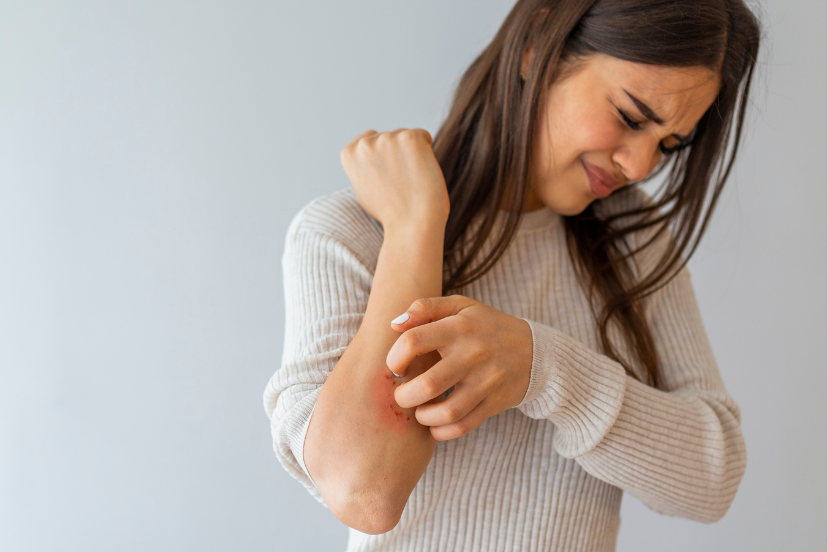Celiac Eczema: Celiac Disease and Skin Health Connection
Hey there, folks! If you’ve stumbled upon this article, you’re likely seeking answers about the perplexing and often misunderstood topic of Celiac Eczema. Don’t worry; you’re in the right place. We’re going to dive deep into this enigmatic condition, exploring what it is, its symptoms, the link with celiac disease, treatment options, and more. So, grab a cup of tea, get cozy, and let’s embark on this enlightening journey together.
Celiac Eczema: What’s the Deal?
Understanding Celiac Eczema
Celiac eczema, also known as dermatitis herpetiformis, is a skin condition that often accompanies celiac disease. It’s like the sidekick to the main superhero – in this case, celiac disease. It’s an itchy, blistering skin rash that can be quite a nuisance. The term “dermatitis herpetiformis” may sound a bit intimidating, but don’t worry; we’ll simplify it for you.
This condition gets its name from the Latin words ‘dermatitis,’ meaning inflammation of the skin, and ‘herpetiformis,’ which suggests a herpes-like appearance of the rash. However, it has nothing to do with the herpes virus – just a quirky name. CE is like a red flag raised by your skin, signaling that something is not right internally, mainly your gut.
Symptoms: The Telltale Signs of Celiac Eczema
1. Itchy, Blistering Rash
The most prominent symptom of CE is the appearance of a relentless, itchy rash with blisters. These blisters are tiny, but they can be incredibly irritating. Imagine having mosquito bites that never seem to go away – that’s what the itching feels like.
2. Elbow and Knee Predilection
Celiac eczema often targets specific areas of the body, particularly the elbows and knees. It can also appear on your buttocks, lower back, and the back of your neck. This pattern of distribution can be a significant clue for medical professionals.
3. Grouped Blisters
The rash typically consists of grouped blisters or red bumps. These are the hallmark of dermatitis herpetiformis. The grouping can be an indicator that you’re not dealing with ordinary eczema.
4. Persistent Discomfort
CE is known for its persistence. The itching and rash can linger for weeks or even months, causing significant discomfort and distress.
5. Gluten Sensitivity or Celiac Disease
This is where the plot thickens. Many individuals with CE also have celiac disease or gluten sensitivity. This close connection between the two conditions is what sets celiac eczema apart from other skin issues.
The Celiac Eczema – Celiac Disease Connection
1. Shared Genetic Roots
Both CE and celiac disease share a common genetic predisposition. They are like distant cousins who inherited similar genes. Individuals with certain gene variants are more susceptible to developing both conditions.
2. Immune System Shenanigans
Your immune system plays a central role in this tale. In celiac disease, the immune system goes haywire when gluten is ingested, attacking the lining of the small intestine. In CE, the immune system’s misguided response triggers the skin rash. It’s like a mix-up in their duties.
3. Gluten as the Culprit
The main villain in this story is gluten – a protein found in wheat, barley, and rye. Gluten acts as a trigger for both celiac disease and celiac eczema. When individuals with these conditions consume gluten, it sets off a chain reaction leading to their respective symptoms.
So, it’s not just a mere coincidence; there’s a scientific explanation behind the link between CE and celiac disease.
Diagnosis: Cracking the Celiac Eczema Code
1. Skin Biopsy
The most reliable way to diagnose CE is through a skin biopsy. A dermatologist will take a small sample of the affected skin and examine it under a microscope. This reveals the telltale signs of dermatitis herpetiformis.
2. Blood Tests
In some cases, blood tests may also be used to detect elevated levels of specific antibodies that are associated with celiac disease and CE. These include anti-tissue transglutaminase (tTG) and anti-endomysial antibodies (EMA).
3. Medical History and Symptoms
Your medical history and the presence of celiac disease or gluten sensitivity symptoms can be valuable clues. Be prepared to discuss your symptoms and any family history of these conditions with your healthcare provider.
Treatment: Soothing the Skin and Taming Celiac Eczema
1. Gluten-Free Diet
The cornerstone of managing CE is adopting a strict gluten-free diet. This means avoiding all sources of gluten, including wheat, barley, rye, and any products containing these grains. Going gluten-free can significantly reduce the frequency and severity of outbreaks.
2. Medications
In some cases, medications may be prescribed to alleviate the itching and rash. Dapsone is a commonly used medication for CE, as it can provide relief from symptoms. However, its long-term use may have side effects, so it should be used with caution.
3. Skin Care
Proper skin care is essential to minimize discomfort and prevent infections. Keep the affected area clean and dry, and avoid scratching to prevent further damage. Topical treatments, such as corticosteroid creams, can also help with symptom management.
4. Consult a Dermatologist
A dermatologist who specializes in skin conditions like celiac eczema can be your best ally in this journey. They can offer guidance, treatment options, and monitor your progress.
FAQs: Your Burning Questions, Answered
Q1: Is celiac eczema contagious?
A1: No, celiac eczema is not contagious. It’s an autoimmune skin condition triggered by a gluten intolerance, and it cannot be spread from person to person.
Q2: Can celiac eczema be mistaken for other skin conditions?
A2: Yes, CE can be misdiagnosed as other skin conditions like regular eczema, psoriasis, or even allergies. That’s why it’s crucial to consult a dermatologist for an accurate diagnosis.
Q3: Does everyone with celiac disease develop celiac eczema?
A3: No, not everyone with celiac disease develops celiac eczema. It’s estimated that only a minority of individuals with celiac disease experience this skin condition.
Q4: Can celiac eczema go away on its own without treatment?
A4: Celiac eczema typically doesn’t go away on its own. It may require a gluten-free diet and, in some cases, medication to manage the symptoms.
Q5: Is there a cure for celiac eczema?
A5: There is no known cure for celiac eczema, but it can be effectively managed through a gluten-free diet and medications to control symptoms.
Q6: Can celiac eczema impact a person’s quality of life?
A6: Yes, celiac eczema can significantly impact a person’s quality of life due to the chronic itching and discomfort associated with the condition. However, with proper management, the impact can be minimized.
In Conclusion: Navigating the Celiac Eczema Journey
Celiac eczema may be an unexpected companion for those dealing with celiac disease or gluten sensitivity, but it’s not a lost cause. With the right approach, you can effectively manage the symptoms and lead a more comfortable life.
Remember, if you suspect you have CE, don’t hesitate to consult a healthcare professional, ideally a dermatologist, for proper diagnosis and guidance. A gluten-free diet is your best friend in this journey, and with the right support and treatment, you can keep the itchy blisters at bay.
So, if you or someone you know is dealing with celiac eczema, you’re not alone, and there is hope. The connection between celiac disease and this skin condition might be complex, but with knowledge and proper care, you can reclaim control of your skin health.




